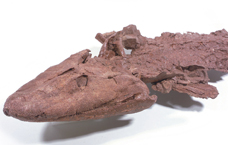Amphibians The word amphibian means “double life,” referring to the fact that these animals live in water as larvae but on land as adults. Amphibians are vertebrates that also, with some exceptions, require water for reproduction, breathe with lungs as adults, have moist skin with mucous glands, and lack scales and claws.  DOL•52–DOL•53
DOL•52–DOL•53
BUILD Vocabulary
WORD ORIGINS The word tetrapod comes from the Greek words “tetra,” meaning four, and “pod,” meaning foot.
▸ The Unique “Fishapod” The general story of early amphibian evolution has been known for years. Several fossils indicate that various lines of lobe-finned fishes evolved sturdier and sturdier appendages, which resembled the limbs of tetrapods. But in recent years, a series of spectacular transitional fossils have been discovered that document in detail the skeletal transformation from lobe-fins to limbs, as shown in Figure 26–9. One of the most interesting of these finds is Tiktaalik, a fossil of which is shown in Figure 26–10. It is an animal with such a mix of fish and tetrapod features that its discoverers informally referred to it as a “fishapod”—part fish, part tetrapod.

FIGURE 26–10 Tiktaalik, the Fishapod The 375-million-year-old Tiktaalik fossil was discovered in Canada in 2004. It is considered a transitional fossil because it shows features of both tetrapods and the fish they evolved from—fins with wrist bones; gills and lungs. Tiktaalik could swim and breathe underwater like a fish OR crawl and breathe out of water like a tetrapod, so its discoverers called it a “fishapod.”
▸ Terrestrial Adaptations Of course, life on land requires more than just legs to crawl around on. Early amphibians also evolved ways to breathe air and protect themselves from drying out, as you will read in Chapters 27 and 28. These adaptations fueled another adaptive radiation. Amphibians became the dominant vertebrates of the warm, swampy Carboniferous Period, about 359 to 300 million years ago. But this success didn't last. Climate changes caused many low, swampy habitats to disappear. Most amphibian groups became extinct by the end of the Permian Period, about 250 million years ago. Only three orders of amphibians survive today—frogs and toads, salamanders, and caecilians (see SIL ee unz).
 In Your Notebook Explain how the climate changes of the Permian Period could have caused the decline of amphibians.
In Your Notebook Explain how the climate changes of the Permian Period could have caused the decline of amphibians.
Table of Contents
- Formulas and Equations
- Applying Formulas and Equations
- Mean, Median, and Mode
- Estimation
- Using Measurements in Calculations
- Effects of Measurement Errors
- Accuracy
- Precision
- Comparing Accuracy and Precision
- Significant Figures
- Calculating With Significant Figures
- Scientific Notation
- Calculating With Scientific Notation
- Dimensional Analysis
- Applying Dimensional Analysis




